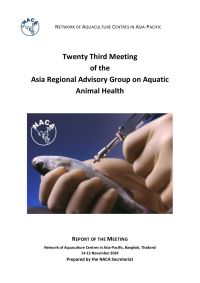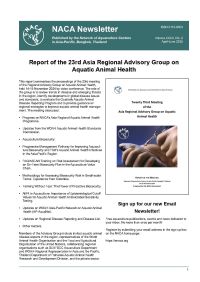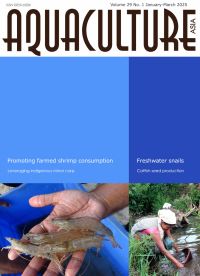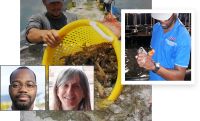This report summarises the proceedings of the 23rd meeting of the Regional Advisory Group on Aquatic Animal Health, held 14-15 November 2024 by video conference. The role of the group is to review trends in disease and emerging threats in the region, identify developments in global disease issues and standards, to evaluate the Quarterly Aquatic Animal Disease Reporting Program and to provide guidance on regional strategies to improve aquatic animal health management.
In this issue:
- Report of the 23rd Asia regional Advisory Group on Aquatic Animal Health.
- Sign up for our new Email Newsletter!
- AQUAINNOVATE: An AquaHub Event.
- Workshop on sustainable brine shrimp Artemia cultivation, 17 February, Tashkent.
- Tuskfish CMS V2.1 released.
- TCRS Shrimp Summit to spotlight issues.
- Global Artemia Summit: 27 June, Entebbe, Uganda.
In this issue:
- Promoting farmed shrimp consumption in India’s domestic market: A step towards sustainability
- Leveraging indigenous minor carp for sustainable aquaculture in Northeast India
- Shaping the future of Indian aquaculture: A path to captive catfish seed success
- Sustainable freshwater snail farming: Advancing nutrition security and rural livelihoods in Northeast India
- Promotion and protection of small fish species through farming: An initiative in Tripura
- NACA Newsletter
PORTSMOUTH, NH: Shrimp experts from around the world will gather in Bali this June for the third annual TCRS Shrimp Summit—a one-of-a-kind event that explores the issues impacting the industry's health and future, from the pond to the market. The summit is unique not just because it represents the full value chain, including major buyers, but because it spotlights the topics, both technical and tactical, that are driving change.
This year's Summit, which takes place 22-25 June, 2025, introduces several new sessions that demonstrate the event's role as a singular forum for investigating the issues that matter.
One such issue is Shrimp Welfare, particularly the use of eyestalk ablation for rapid egg production. Dr. Simão Zacarias, one of the session speakers and a recipient of the 2020 Global Aquaculture Innovation Award, says that, "although eyestalk ablation can boost egg production, it is also associated with female broodstock stress, physiological imbalance, mortality, and compromised diseas resistance in offspring."
Small indigenous fish species (SIS) are a rich source of essential nutrients, including proteins, vitamins, and minerals, making them a vital component of rural diets. Despite their nutritional significance, SIS are often undervalued and excluded from aquaculture in favor of larger commercial species.
This study highlights an initiative by ICAR-CIFA in Tripura to promote and protect small fish species through sustainable farming practices. Training programs were conducted to educate local farmers on breeding, feeding, and rearing techniques tailored to SIS. Live food production was emphasised to improve larval survival rates, and mixed-species culture strategies were developed to enhance production efficiency. The initiative demonstrated that small fish farming is a viable livelihood option, particularly in backyard water bodies, providing food security, income generation, and biodiversity conservation.




